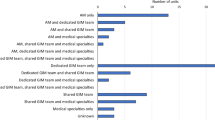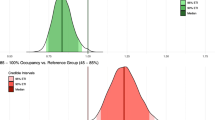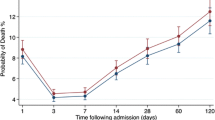Abstract
Objective
To investigate whether mortality in UK intensive care units is higher in winter than in non-winter and to explore the importance of variations in case mix and increased pressure on ICUs.
Design and setting
Cohort study in 115 adult, general ICUs in England, Wales and Northern Ireland.
Patients and participants
113,389 admissions from 1995 to 2000.
Measurements and results
Hospital mortality following admission to ICU was compared between winter (December–February) and non-winter (March–November). The causes of any observed differences were explored by adjusting for the case mix of admissions and the workload of the ICUs. Crude hospital mortality was higher in winter. After adjusting for case mix using the APACHE II mortality probability this effect was reduced but still significant. When additional factors reflecting case mix and workload were introduced into the model, the overall effect of winter admission was no longer significant. Factors reflecting both the case mix of the individual patient and of the patients in surrounding beds were found to be significantly associated with outcome. After adjustment for other factors, the occupancy of the unit (proportion of beds occupied) was not significantly associated with mortality.
Conclusions
The excess winter mortality observed in UK ICUs can be explained by variation in the case mix of admissions. Unit occupancy was not associated with mortality.

Similar content being viewed by others
References
Curwen M (1990/91) Excess winter mortality: a British phenomenon? Health Trends 4:169–175
Laake K, Sverre JM (1996) Winter excess mortality: a comparison between Norway and England plus Wales. Age Ageing 25:343–348
Kendrick S, Frame S, Povey C (1997) Beds occupied by emergency patients: long-term trends in patterns of short-term fluctuation in Scotland. Health Bull (Edinb) 55:167–175
Keatinge WR (2002) Winter mortality and its causes. Int J Circumpolar Health 61:292–299
Office for National Statistics (2002) Mortality statistics: general. Review of the Registrar General on deaths in England and Wales, 2000. Series DH1 no.33. Office for National Statistics, London
Padkin A, Goldfrad C, Brady AR, Young D, Black N, Rowan K (2003) Epidemiology of severe sepsis occurring in the first 24 hrs in intensive care in England, Wales, and Northern Ireland. Crit Care Med 31:2332–2338
Garfield M, Ridley S, Kong A, Burns A, Blunt M, Gunning K (2001) Seasonal variation in admission rates to intensive care units. Anaesthesia 56:1136–1140
Tarnow-Mordi WO, Hau C, Warden A, Shearer AJ (2000) Hospital mortality in relation to staff workload: a 4-year study in an adult intensive care unit. Lancet 356:185–189
UK Neonatal Staffing Study Group (2002) Patient volume, staffing, and workload in relation to risk-adjusted outcomes in a random stratified sample of UK neonatal intensive care units: a prospective evaluation. Lancet 359:99–107
Goldfrad C, Rowan K (2000) Consequences of discharges from intensive care at night. Lancet 355:1138–1142
Rowan K, Black N (2000) A bottom-up approach to performance indicators through clinician networks. Health Care UK, Spring:42–46
Department of Health (2000) Comprehensive critical care: a review of adult critical care services. Department of Health, London
Knaus WA, Draper EA, Wagner DP, Zimmerman JE (1985) APACHE II: a severity of disease classification system. Crit Care Med 13:818–829
Leach CE, Blair PS, Fleming PJ, Smith IJ, Platt MW, Berry PJ, Golding J (1999) Epidemiology of SIDS and explained sudden infant deaths. CESDI SUDI Research Group. Pediatrics 104:e43
Pell JP, Sirel J, Marsden AK, Cobbe SM (1999) Seasonal variations in out of hospital cardiopulmonary arrest. Heart 82:680–683
Atkinson W, Harris J, Mills P, Moffat S, White C, Lynch O, Jones M, Cullinan P, Newman Taylor AJ (1999) Domestic aeroallergen exposures among infants in an English town. Eur Respir J 13:583–589
Sandberg S, Paton JY, Ahola S, McCann DC, McGuinness D, Hillary CR, Oja H (2000) The role of acute and chronic stress in asthma attacks in children. Lancet 356:982–987
Fullerton KJ, Crawford VLS (1999) The winter bed crisis: quantifying seasonal effects on hospital bed usage. Q J Med 92:199–206
Rowan KM (1992) Outcome comparison of intensive care units in Great Britain and Ireland using the APACHE II method. Thesis, University of Oxford
Knaus WA, Draper EA, Wagner DP, Zimmerman JE (1985) Prognosis in acute organ system failure. Ann Surg 202:685–693
Wunsch H, Mapstone J, Brady T, Hanks R, Rowan K (2004) Hospital mortality associated with day and time of admission to intensive care units. Intensive Care Med 30:895–901
Morales IJ, Peters SG, Afessa B (2003) Hospital mortality rate and length of stay in patients admitted at night to the intensive care unit. Crit Care Med 31:858–863
Selker HP (1993) Systems for comparing actual and predicted mortality rates: characteristics to promote cooperation in improving hospital care. Ann Intern Med 118:820–822
Boyd O, Grounds RM (1993) Physiological scoring systems and audit. Lancet 341:1573–1574
Rutledge R (1996) The Injury Severity Score is unable to differentiate between poor care and severe injury. J Trauma 40:944–950
Shann F, Pearson G, Slater A, Wilkinson K (1997) Paediatric index of mortality (PIM): a mortality prediction model for children in intensive care. Intensive Care Med 23:201–207
Acknowledgements
We thank all the staff in the ICUs participating in the Case Mix Programme and those responsible for local funding.
Author information
Authors and Affiliations
Corresponding author
Additional information
This research was supported by: Intensive Care National Audit and Research Centre, Ramathibodi Hospital and Medical School, and ESRC Research Methods (grant H 333 25 0047)
Electronic Supplementary Material
Rights and permissions
About this article
Cite this article
Harrison, D.A., Lertsithichai, P., Brady, A.R. et al. Winter excess mortality in intensive care in the UK: an analysis of outcome adjusted for patient case mix and unit workload. Intensive Care Med 30, 1900–1907 (2004). https://doi.org/10.1007/s00134-004-2390-6
Received:
Accepted:
Published:
Issue Date:
DOI: https://doi.org/10.1007/s00134-004-2390-6




